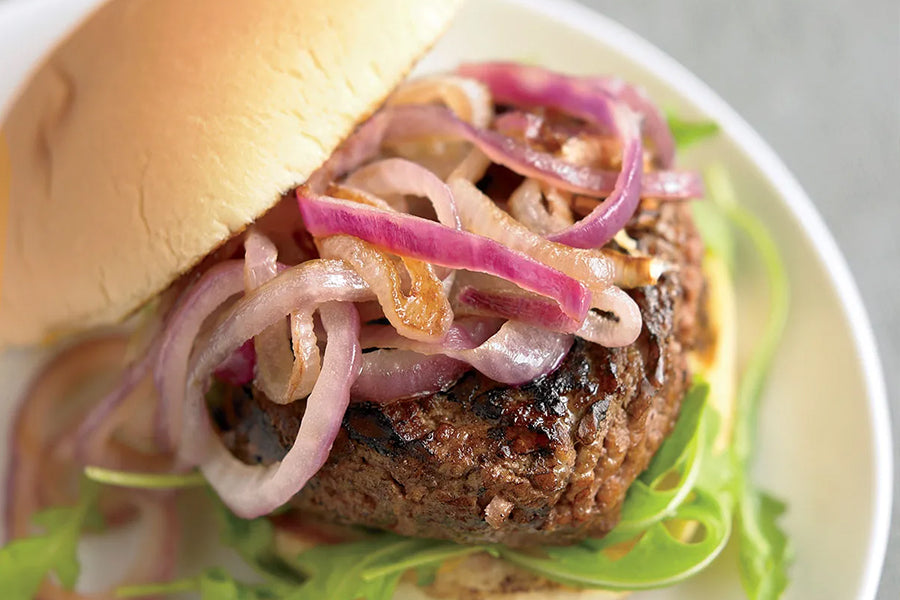There is nothing quite like a juicy beef patty. Whether you are grilling them up for a backyard barbecue or cooking them on the stove top, they always seem to hit the right spot. But have you ever wondered what goes into making a beef patty?
Generally speaking, most beef patties are made from ground beef and seasonings. The beef is usually grounded coarsely, which helps to create a juicier patty. Once the beef is mixed with the seasonings, it's formed into patties and then cooked.
Of course, there are endless variations to this basic recipe. Some recipes call for adding breadcrumbs or other fillers to the mix, while some include eggs or other binders. And, of course, the seasonings and sauces can be customized to your liking. Whether you prefer them plain or loaded with cheese and bacon, there's always a beef patty recipe for you.
So, if you're in the mood for a burger, why not try making your own beef patties in Swedish style with onion sauce? Let’s make one!
Nutrition Facts
Serves 4 persons
|
Calories |
495.7 cal |
|
Carbohydrates |
27.5 g |
|
Proteins |
26 g |
|
Fats |
31.3 g |
Time Required
|
Preparation Time |
25 Minutes |
|
Cooking Time |
20 Minutes |
|
Total Time Needed |
45 Minutes |
Ingredients
- 1lb ground beef
- 4 tablespoons of fresh breadcrumbs
- 1 egg
- 1/2 cup of milk
- 1/2 teaspoon of ground allspice
- 1 teaspoon of ground ginger
- 2 tablespoons chopped onions (or 1 teaspoon of onion powder)
- 1/2 teaspoon of salt
- Fresh ground pepper
- 4 onions, sliced
- 4 tablespoons of butter
- 1 teaspoon of sugar
- 1 cup water
Directions
- Take 2 tbsp of butter and melt it in a pan over medium heat. Sauté the chopped onions until they are soft. Add the sugar and continue to cook until they begin to caramelize (turn brown). Remove from the pan and set aside.
- Meanwhile, combine the ground beef, breadcrumbs, egg, milk, allspice, ground ginger, chopped onions, salt, and pepper. Make 4 patties out of the mixture.
- Again take 2 tbsp of butter to melt in a pan over medium heat and fry the patties until they are golden brown. Turn sides so that both sides get brown and properly cooked. Add water and cover the pan with a lid. Cook for 15 to 20 minutes, or until the patties are fully cooked.
- Serve with potatoes, pickles and caramelized onions. Put some Swedish cream sauce on top if you like.
What’s Good in These Patties
Swedish beef patties with onions have numerous beneficial ingredients that make it a good meal. The primary ingredient is ground beef. Many people opt for chicken because of fewer calories and protein, but beef is healthier than chicken. So, beef can be the best option if you're planning to make patties. Let’s see what these delicious patties have to offer to you!
Provides Protein
Red meat provides adequate proteins, primarily if you use leaner cuts. Proteins are essential for performing different body functions and are full of amino acids making up the body cells.
A study shows that red meat is a complete protein, containing all the essential amino acids which are not produced by your body and should be taken from food items. Interestingly, the profiling of these amino acids in meat is similar to human beings. It could be one reason why doctors recommend meat, especially after surgery or for recovering athletes.
Related Article: Every Lifter Should Know These 7 Facts About Essential Amino Acids
Full of Micronutrients
Red meat, beef is an excellent source of micronutrients, such as vitamins and minerals. A study found that meat is a rich source of selenium, a critical trace element that helps your body accomplish various activities.
Niacin (vitamin B3) is abundant in meat and serves a variety of functions in the body. As per a study, its deficit has been related to an increased risk of heart diseases. Beef also contains zinc, which is required for body growth and maintenance. A 100 g (3.5-ounce) portion of raw ground beef provides 4.8 mg of zinc, which makes up 44% of the Daily Value.
Beef also contains vitamin B12, vitamin B6, phosphorus, and iron, in addition to these minerals.
Related Article: The Benefits of Multivitamins: 8 Surprising Reasons to Take Them
Supports Workout Performance
Red meat, such as beef, can increase your exercise performance with multiple macro and micronutrients. It also contains other ingredients, such as carnosine, which improves workout performance.
Carnosine is a muscle-functioning molecule that the body produces from beta-alanine, a dietary amino acid found in considerable levels in fish and meat, particularly beef. According to one study, using large doses of beta-alanine for 4–10 weeks increased muscle carnosine levels by 40% to 80%. Carnosine levels in human muscles have been linked to reduced fatigue and improved exercise performance.
Conjugated Linoleic Acid
Beef is a good source of CLA after lamb meat. Conjugated linoleic acid, sometimes known as CLA, is a naturally present trans-fat. While "trans-fat" may sound frightening, it has a different effect than its synthetic counterpart. Human participants in a randomized controlled trial imply that:
- Insulin sensitivity is improved by conjugated linoleic acid.
- CLA appears to help people lose weight.
May Treat Iron Deficiency
Iron deficiency in humans may cause anemia, which is caused by the decreased number of red blood cells to transport oxygen within the body. Its symptoms could be fatigue, weakness, dizziness, and pale appearance.
However, you can treat anemia through red meat consumption because iron is abundantly present in red meat as heme iron. Fortunately, the human body can absorb heme iron. The other type of iron is non-heme, which is present in plants. Red meat provides its own heme iron to the body and assists in the uptake and absorption of non-heme iron taken from plant-based foods through a process called the meat factor that has yet to be explained.
Taking meat supplements is also beneficial over iron tablets for women to keep their iron level in check during workouts and exercise.
The Bottom Line
For many people, a beef patty is the ultimate comfort food. There's just something about the savoury taste and juicy texture that hits the spot, no matter what you feel. And while it might not seem like the healthiest option, there are actually a lot of benefits to including beef patties in your diet.
Beef is an excellent source of protein. This essential nutrient helps build and repair muscle tissue and other bodily functions. They are also a good source of iron, which is necessary for carrying oxygen throughout the body. Additionally, beef contains vitamins and minerals essential for energy production and immune system function. It supports your workout performance besides giving you adequate CLAs.
So next time you're looking for a quick and easy meal, don't hesitate to reach for this beef patty recipe!
Reading List
Article Sources
- Derave, Wim, et al. “Beta-Alanine Supplementation Augments Muscle Carnosine Content and Attenuates Fatigue during Repeated Isokinetic Contraction Bouts in Trained Sprinters.” Journal of Applied Physiology (Bethesda, Md.: 1985), vol. 103, no. 5, Nov. 2007, pp. 1736–43. PubMed, https://doi.org/10.1152/japplphysiol.00397.2007.
- Garibay-Nieto, Nayely, et al. “Effects of Conjugated Linoleic Acid and Metformin on Insulin Sensitivity in Obese Children: Randomized Clinical Trial.” The Journal of Clinical Endocrinology and Metabolism, vol. 102, no. 1, Jan. 2017, pp. 132–40. PubMed, https://doi.org/10.1210/jc.2016-2701.
- Lavigne, Paul M., and Richard H. Karas. “The Current State of Niacin in Cardiovascular Disease Prevention: A Systematic Review and Meta-Regression.” Journal of the American College of Cardiology, vol. 61, no. 4, Jan. 2013, pp. 440–46. PubMed, https://doi.org/10.1016/j.jacc.2012.10.030.
- Lyle, R. M., et al. “Iron Status in Exercising Women: The Effect of Oral Iron Therapy vs Increased Consumption of Muscle Foods.” The American Journal of Clinical Nutrition, vol. 56, no. 6, Dec. 1992, pp. 1049–55. PubMed, https://doi.org/10.1093/ajcn/56.6.1049.
- Rayman, Margaret P. “Selenium and Human Health.” Lancet (London, England), vol. 379, no. 9822, Mar. 2012, pp. 1256–68. PubMed, https://doi.org/10.1016/S0140-6736(11)61452-9.
- Sale, Craig, et al. “Effect of Beta-Alanine Supplementation on Muscle Carnosine Concentrations and Exercise Performance.” Amino Acids, vol. 39, no. 2, July 2010, pp. 321–33. PubMed, https://doi.org/10.1007/s00726-009-0443-4.
- Valenzuela, Carolina, et al. “Total Iron and Heme Iron Content and Their Distribution in Beef Meat and Viscera.” Biological Trace Element Research, vol. 132, no. 1–3, Dec. 2009, pp. 103–11. PubMed, https://doi.org/10.1007/s12011-009-8400-3.
- Wyness, L., et al. “Red Meat in the Diet: An Update: Red Meat Update.” Nutrition Bulletin, vol. 36, no. 1, Mar. 2011, pp. 34–77. DOI.org (Crossref), https://doi.org/10.1111/j.1467-3010.2010.01871.x.
 Skip to content
Skip to content











